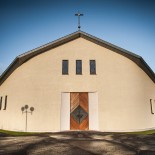The Early Period
In the time of St Patrick this parish was in the territory of the Ui Tuirtre who were visited by St Patrick on his apostolic mission through Ireland. The chief family of the Ui Tuirtre were th O’Lynns who gave their name to the fortified crannoge of Lough Inis O’Lynn at Desertmartin and also to the Barony of Loughinsholin. The surname Lynn is still prevalent in our parish. In the 15th, 16th and 17th centuries the Lynns were prominent ecclesiastics – especially in the Dominican Priories of Coleraine and Derry. John O Lynn was Prior of Derry at the end of the 16th century. He suffered martyrdom at Derry along with some diocesan priests in 1608. His brother, William also died for the Faith a short time before this. We find a friar, Thomas O Lynn, a Dominican of Derry, as early as 1480.
From the 15th century until the Plantation in the 17th century, this area was ruled by a branch of the O’Neills of Clandeboye – Clann Domhnaill Doinn na Banna. The most celebrated descendant of Domhnall Donn was Brian Carrach O’Neill who had his stronghold at the Crannog of Innishrush (now called The Green Lough). Brian Carrach was subject to the O’Neills of Tyrone. In Marshal Bagenal’s “Description of Ulster”, in 1586, the region is described as “Brian Carraghe’s countrey” and as “the fastest grownde of Irelande” – meaning that it was the most impenetrable place in the country because of its dense oak forest. On the maps of the period the area is marked as “Bryan Carraghe’s Countrie”.
Brian Carrach died in 1586. He had two sons and one daughter, Anne. Anne married the last Lord of Clannaboye, Shane MacBryan O’Neill of Shane’s Castle, Antrim. Anne was Shane’s second wife and they had two sons, Arthur (who married Grace, daughter of Cahal O’Hara of Crebilly) and Feilim Dubh (who married Shel, Grace’s sister). The oak piles on which Brian Carrach’s crannog was built are still preserved in the dried up lake of Greenlough. Among the artefacts found on the site of the crannog was a coat of mail and the equipage of horses, along with various household utensils. The crannog is now in state care.






